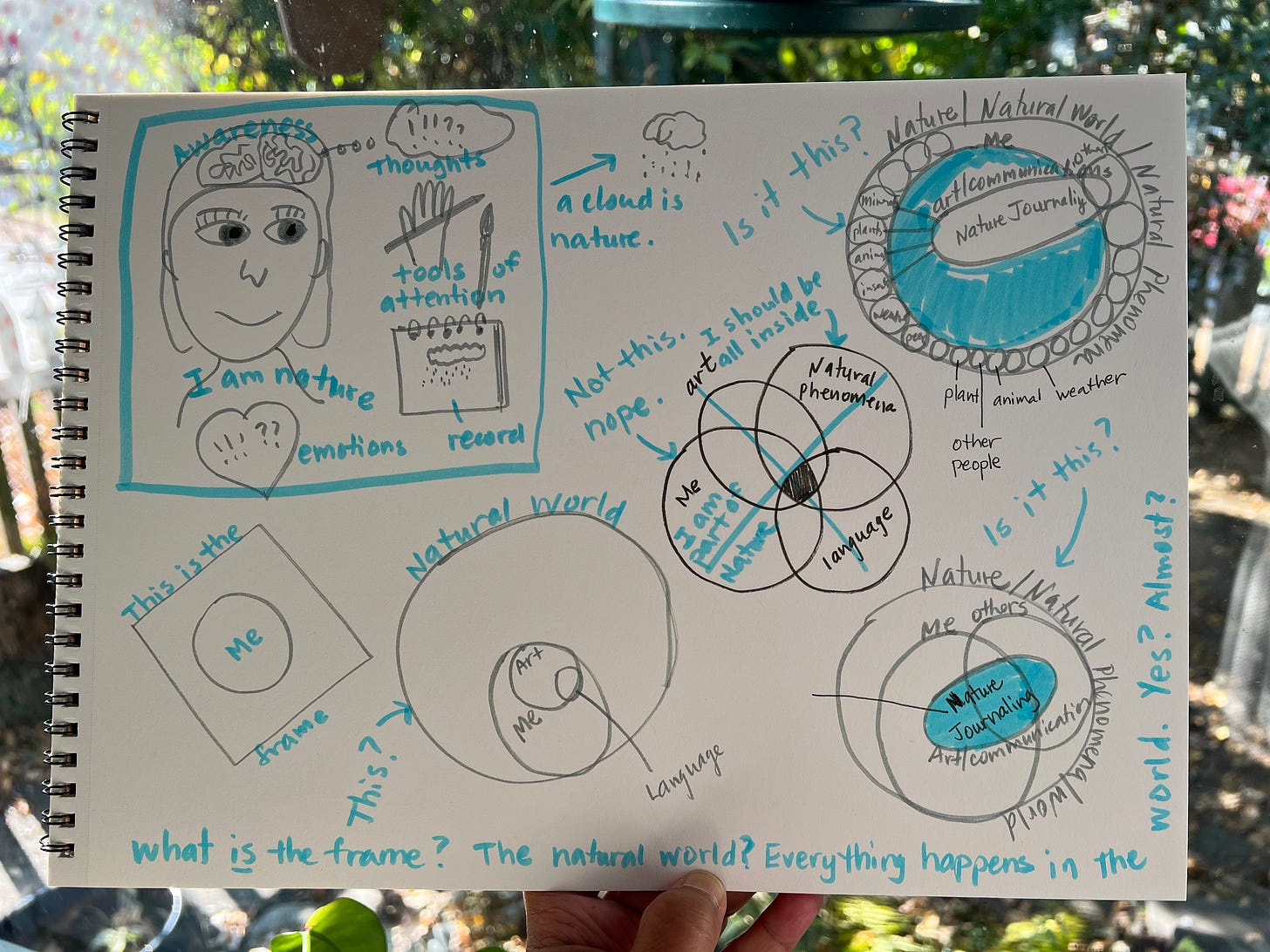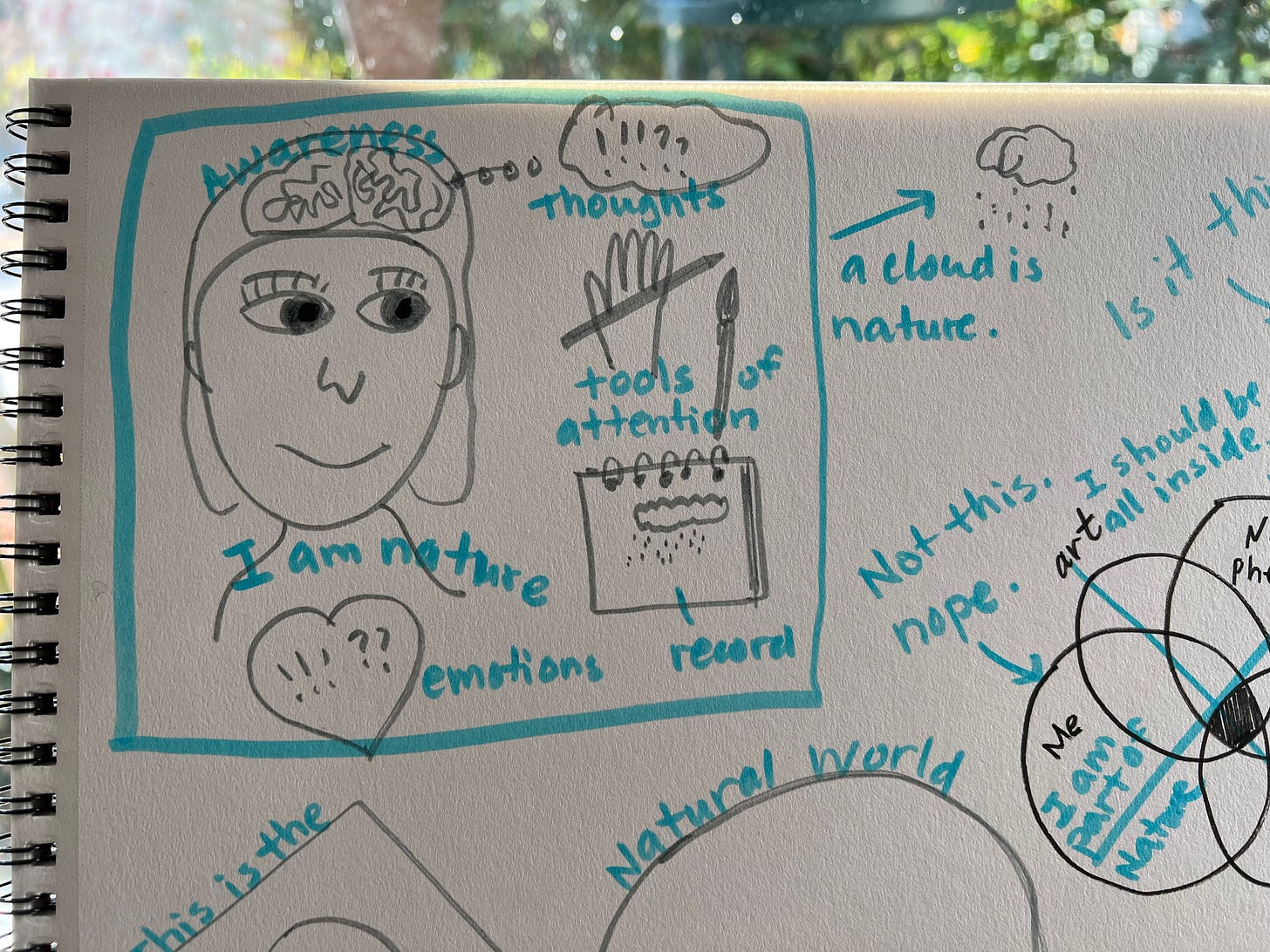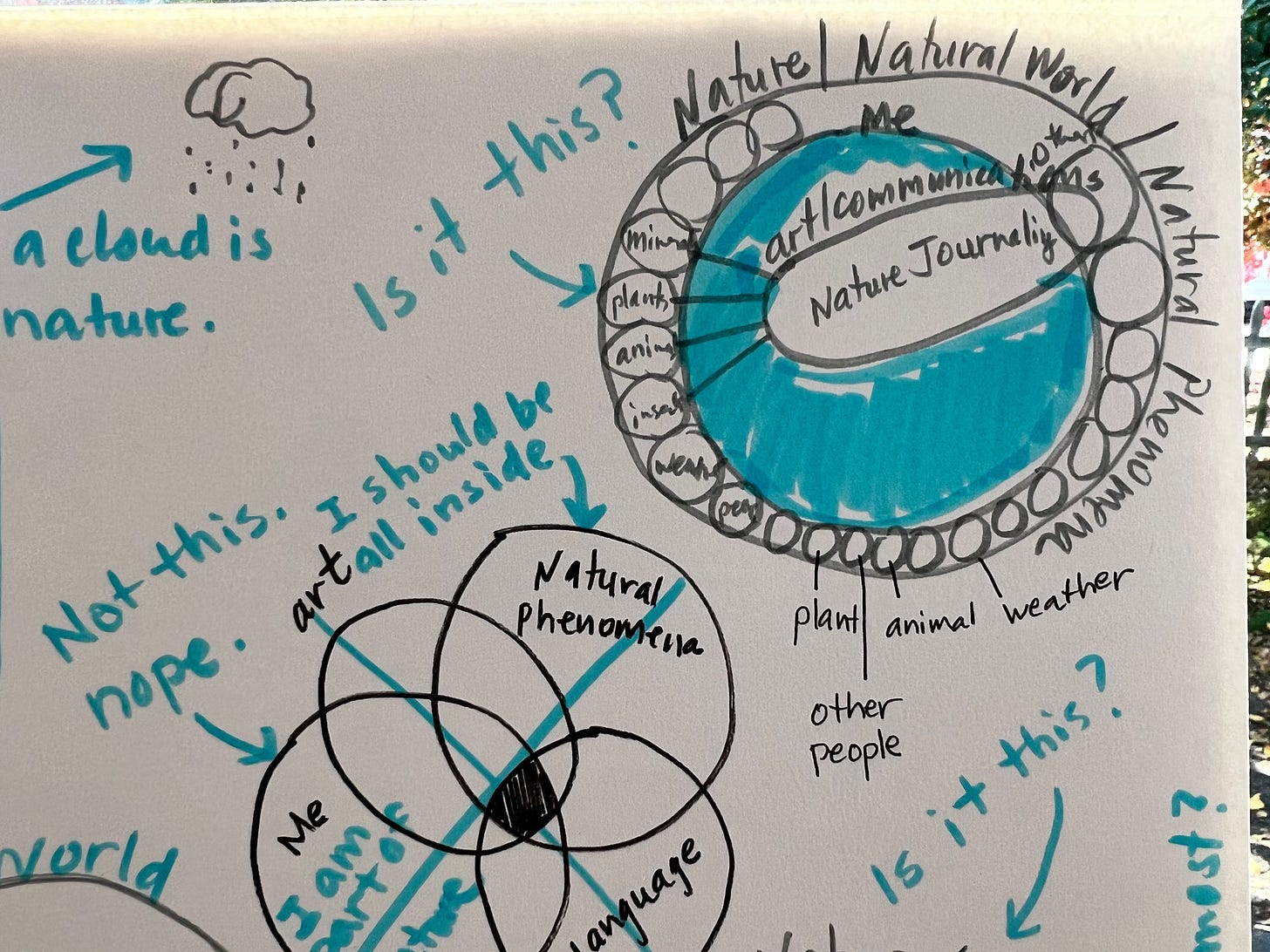
Hello, Nature Nerds!
I’m so glad you chose, once again, to be here with me. And if you are new, then welcome! This newsletter gives readers a closer look at my nature journal pages and into the ways that I believe the practices of nature journaling can not only deepen our connection to the natural world but help us live happier, healthier lives.
One of the most delightful and revolutionary sentences I heard during the 2022 Wild Wonder Nature Journaling Conference came from John Muir Laws, conference host and author of the Law’s Guide to Nature Drawing and Journaling. At the beginning of the Zoom talk he sits at an angle to the screen. The landscape painting hanging on the wall behind him is askew. The camera itself must be tilted because the view of the room is also tilted. Then, 30 seconds after he begins speaking, he says, We are not showing you the right way to do it [nature journaling]. After a dramatic pause, he goes on to say, “We have this whole conference of people not showing you the right way to do it, because there's so many different ways to do it. And if you're doing it different (sic) than any of those ways, you're still doing it right.”
I love the playful way that John Muir Laws gets this idea across and I agree with him whole-heartedly. There is no one way to keep a nature journal. But… with so many different ways to keep a nature journal and the “right way” being precisely the way that I pick or you pick, why is there even a need or reason to come up with a definition?
I didn’t realize, until a conversation with a prospective workshop participant made it plain, that I took it for granted that anyone encountering the two terms, “nature” and “journaling” together would naturally understand what I meant.
This newsletter is out a little bit later than usual because it required a lot more time and reflection for me to arrive at an answer. To start my thinking, I drew Venn diagrams and pictures. I have sprinkled images of my visual representations throughout this post. I hope they amuse you as much as they did me.
There are many definitions out in the universe already, and I could have easily found one that I liked and quoted that person. But, what I really wanted to do was answer this question from a more personal standpoint. How would I answer, for example, if a friend or a workshop participant asked me this question? Could I give an answer that reflects who I am as a practitioner and teacher of nature journaling as well as the what and the why?
By nature, I am a person who likes to think “outside the box.” I like expansive thinking. Unsurprisingly then, this idea that a nature journal can take many different forms, probably as many as there are individual nature journal keepers, is exactly where I want my imagination to go. That part of me that wants spaciousness enjoys this open ended definition. At the same time, there is another part of me, which paradoxically, needs order and predictability to feel safe. This part of me needs some basic framework to feel grounded. This part of me wants to come up with a clear concept of what the product and the process of nature journaling is. And I now realize that other people might appreciate a definition as well.
Nature journaling is a particular form of paying attention. It is a medium through which we can deepen our connection to nature.

I’ve been on my nature journaling journey for several years and the term “nature journaling” has become so familiar. This may be why I didn't realize, until a conversation with a prospective workshop participant made it plain, that I took it as granted that anyone encountering the two terms “nature” and “journaling” together would naturally understand what I meant. I invited this person to go on a nature journaling walk with me, to which they responded, “I love nature walking, and enjoy what I know of plants but would like to know more, I think that's the main thing I want. I don't tend to journal much at all and am not sure how to incorporate more of that into my life in general, let alone as it pertains to nature.” Reading between the lines, I understood this person was telling me that they had no prior concept of nature journaling. Roughly the same conversation happened again with a friend, who asked directly, “What IS nature journaling?”

Here is how I responded to this person: Nature journaling is a particular form of paying attention. It is a medium through which we can deepen our connection to nature.
This answer gets to what I see as the universal Why of nature journaling. In my response to my friend, I wish now that I had added the aspects of art/creativity, curiosity, awe and writing because these are also a big part of my nature journaling.
In addition, I would have liked to tell her that though many nature journal keepers use some form of art in our journals, I have heard many different people say that it isn’t about “making a pretty picture,” however. It’s essentially about making a connection to nature. Every nature journal keeper I know loves nature and wants to deepen that relationship through their journal, in whatever form that takes. Just as every journal keeper keeps their journal in a way unique to them, the reasons we keep our journals are also nuanced. These reasons can include but are not limited to one or more of the following:
to inspire creativity
to conduct scientific inquiry
to communication with other naturalists
for personal reference
to enhance a memory
to earn a living
to teach
to belong to a community
to join a movement
to join a tradition
And in an earlier post I wrote about how journaling out in nature helps me cope with Generalized Anxiety Disorder.1
Before I close, I want to share just a little more about my particular Why. Why do I maintain the practices2 of nature journaling and why I am sharing my reasons with other people through this newsletter?

We have many problems or challenges, both personal and collective, about our physical world (e.g. climate change, species loss) and cultural world (e.g. jobs, money, systemic and structural inequalities) that absolutely need our attention and energy right now. This is work that is essential for our day to day survival as well as the survival of our plant and animal relatives and all beings yet to be. It is work that is hard and work that we need to return to every day. It is work that can be exhausting.
Everyone’s situation differs in the amount of room and resources we have for rest but everyone undeniably needs rest and restoration. Learning to keep a nature journal will not fix the big problems we are facing but it can help us find a space to REST. Moreover, it can also be a way to make room for and practice other useful skills such as, but not limited to, the ability to experience and cultivate wonder, curiosity, humility, connection, and play, all of which are restorative and, therefore, can help us to face our problems more resourced and more centered, perhaps, even, with more compassion and creativity. And nature journaling can be as accessible as a piece of paper, a pencil, a step or two outside our door, and a handful of time.
Thank you again for reading A Wild Braid Nature Journal. This is a reader supported publication and your support is sincerely appreciated.
Sincerely,
Alma
A Wild Braid Nature Journal is part of A Wild Braid project in which my mission is to show ways that nature walking, nature journaling, and creativity can be easily accessible, especially for those who think they have no time or have no artistic skill. To learn more, please visit www.awildbraid.com.
To support this project you can do one or more of the following:
Tell me what you wonder: about nature, about nature journaling. I can’t guarantee that I will have an answer but your questions might spark a fruitful inquiry and I’ll be happy to share what I discover or already know.
Subscribe to this newsletter. It’s free!
Share A Wild Braid Nature Journal with someone
Follow me on Instagram @awildbraid
Leave a donation
Workshops coming soon! Leave a message through awildbraid.com to let me know if you are interested
I’m deliberately using the plural '“practices” because I believe there is more to nature journaling than creating a physical artifact. More about this in a later post.


